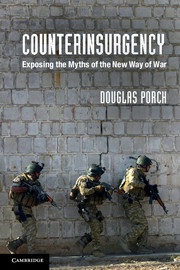Book contents
- Frontmatter
- Contents
- List of illustrations
- List of maps
- Preface and acknowledgments
- 1 A “happy combination of clemency with firmness”: the small wars prologue
- 2 The road from Sedan
- 3 The paroxysms of imperial might in the shadow of the Great War
- 4 From Tipperary to Tel Aviv: British counterinsurgency in the World War II era
- 5 From small wars to la guerre subversive: the radicalization and collapse of French counterinsurgency
- 6 Vietnam, counterinsurgency, and the American way of war
- 7 “A conspiracy of heroes”: revolution and counterinsurgency in Latin America
- 8 Building the “most successful counterinsurgency school”: COIN as the British way of war
- 9 Britain’s Thirty Years’ War in Northern Ireland
- 10 Vietnam with a happy ending: Iraq and “the surge”
- 11 Conclusion
- Notes
- Select bibliography
- Index
8 - Building the “most successful counterinsurgency school”: COIN as the British way of war
Published online by Cambridge University Press: 05 June 2014
- Frontmatter
- Contents
- List of illustrations
- List of maps
- Preface and acknowledgments
- 1 A “happy combination of clemency with firmness”: the small wars prologue
- 2 The road from Sedan
- 3 The paroxysms of imperial might in the shadow of the Great War
- 4 From Tipperary to Tel Aviv: British counterinsurgency in the World War II era
- 5 From small wars to la guerre subversive: the radicalization and collapse of French counterinsurgency
- 6 Vietnam, counterinsurgency, and the American way of war
- 7 “A conspiracy of heroes”: revolution and counterinsurgency in Latin America
- 8 Building the “most successful counterinsurgency school”: COIN as the British way of war
- 9 Britain’s Thirty Years’ War in Northern Ireland
- 10 Vietnam with a happy ending: Iraq and “the surge”
- 11 Conclusion
- Notes
- Select bibliography
- Index
Summary
The COIN-dinista gospel asserts that there is a right way and a wrong way to fight insurgencies. In Algeria the French were too brutal, in the process solidifying Muslim support for the FLN, constricting government policy options, undermining support for the war at home and abroad, and politicizing French counterinsurgents to the point of mutiny. The US military failed in Vietnam for different, but equally systemic reasons – the “American way of war,” the counterinsurgents’ argument goes, dictates a conventional, firepower-focused force structure that is ill-matched to a COIN environment. Only the British, this argument continues, managed the intellectual and operational transition from imperial small wars to contemporary COIN. Thus, while the COIN-dinistas’ shared memory starts with Vietnam, their folklore begins with Sir Robert Thompson’s 1966 book, Defeating Communist Insurgency. Thompson boasted impeccable COIN credentials – an RAF officer who had fought as a Chindit under Orde Wingate in Burma during World War II, he graduated through the small wars hierarchy during the Malaya Emergency (1948–1960) serving successively as staff officer to Sir Harold Briggs, Director of Operations in Malaya in 1950–1951, as coordinating officer for security under Briggs’ successor, Sir Gerald Templer, and Deputy Secretary for Defence after Malayan independence in 1957, moving to Permanent Secretary for Defence in 1959. He subsequently advised both Presidents Kennedy and Nixon during the Vietnam War. Thompson argued that in Malaya, which in the COIN-dinista view set the gold standard of post-World War II counterinsurgency, the British achieved the correct balance of persuasion and force by establishing some basic principles.
- Type
- Chapter
- Information
- CounterinsurgencyExposing the Myths of the New Way of War, pp. 246 - 267Publisher: Cambridge University PressPrint publication year: 2013
- 8
- Cited by



